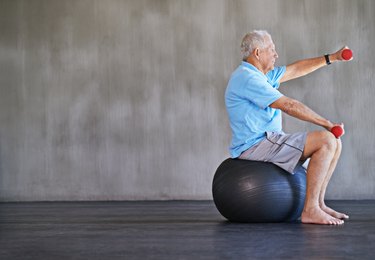
When it comes to lifting weights, do slow and steady reps win the race or do fast and explosive reps take the prize? Is there such a thing as moving too slow, and can going too quickly lead to poor form and results?
Well, like many debates in the fitness industry, the idea of slow reps vs. fast reps has compelling evidence on both sides.
Video of the Day
Video of the Day
Tip
Slow reps and fast reps are both worthwhile training strategies with unique benefits. Combine them in your routine for the best results — just make sure to prioritize good form.
What Is Exercise Tempo?
To truly compare slow vs. fast reps, you first need to understand exactly what repetition speed, or tempo, is. Tempo is how fast you lift and lower a weight or resistance. And it includes the eccentric, isometric and concentric parts of a movement.
The Concentric Phase
"The concentric phase of movement is when a muscle produces a force to overcome a load or resistance placed on it," says certified personal trainer Yusuf Jeffers, CPT, a coach at ToneHouse and Mile High Run Club in New York City.
"Technically speaking, what's happening is you're shortening the agonist muscle, or main muscle being worked," says Noam Tamir, CSCS, a certified strength and conditioning specialist and founder of TS Fitness in New York City. When using free weights like dumbbells, this is the lifting part of the movement.
The Isometric Phase
Next comes the isometric part of a rep. "The isometric phase is when the forces produced by the muscles are equal to the resistance placed on it," Jeffers says. "This leads to no movement at all."
This is also sometimes the "pause" portion of a rep, where you briefly pause before you finish the rep, like at the bottom of an air squat or the top of a dumbbell deadlift.
The Eccentric Phase
Last is the eccentric stage. "The eccentric portion of a movement is where muscles being used exert less force than resistance placed on them causing a lengthening of the muscle," Jeffers explains. This is also sometimes referred to as the negative portion of a rep.
"Anatomically speaking, in this phase, you're lengthening the agonist muscle, or the main muscle doing the work," Tamir says.
Tip
Here's a helpful shorthand for remembering these three stages: Concentric shortens the muscle, isometric holds the muscle static and eccentric lengthens the muscle.
For example, when doing a biceps curl, the concentric phase happens when you curl the dumbbell up toward your shoulders, working against the load. When you pause at the top, you're in the isometric phase. And as you lower the weight down, you enter the eccentric phase, lengthening the muscle and yielding to the load.
Strength-training reps often follow a 1-1-2 tempo:
- 1 second up
- 1 second pause
- 2 seconds down
Tempo variations in workouts to either a faster rep pace or slower tempo alters the effects of exercise.
Benefits of Slow Reps
Whether you're just starting out or you've been lifting weights for years, you might be wondering what the best workout is to build muscle fast. If your goal is hypertrophy or increasing muscle size, then focusing on slow reps to build muscle is a good place to start, according to a June 2018 study in the Journal of Human Kinetics.
"Slow lifts help with increasing recruitment of more muscle fibers to overcome an external resistance," Jeffers says. "Lifting slow eliminates momentum and forces the muscles to work harder through their ranges of motion."
When you do a slow rep workout, your muscles spend more time under tension than they would if you were doing fast reps. Time under tension refers to the amount of time a muscle is under strain. "The time under tension helps to optimize muscular strength, endurance and growth," Jeffers says.
You can achieve this by drawing out one or more of the phases of your rep. For instance, you could use a 2-2-2 tempo, taking 2 seconds to do each portion of the lift. Or, you could use a 2-1-3 tempo: Raise for 2 seconds, pause for 1, lower over the count of 3.
Tip
Slowing down the eccentric, or lowering, portion of the exercise is the most common way to approach slow reps.
A slow lifting technique while using lighter weights is also a safer approach for beginners. Slowing the tempo down allows you to focus on form and make sure you're doing the move correctly. "You will usually use less weight and a lower rep scheme than a typical set," Jeffers says.
Advantages of Fast Reps
If your fitness goals involve max strength and power, then using a faster tempo may be more beneficial. For example, if you're training to improve your vertical jump, you need to be able to not only generate a lot of force, but do so quickly. Fast reps are going to be the best way to do that.
"Fast lifts are mostly used to help develop power output or explosiveness," Jeffers says. "The weight used is typically a very low percentage of a person's one rep max. The focus is mainly working on neurological connections." A good benchmark is to use 70 percent of your one rep max, he says.
Most often, during fast reps, it's the concentric portion of the exercise that is done quickly. For instance, in explosive exercises like power cleans or box jumps, you move quickly against resistance and then take your time getting back to start. This helps you focus on your form during hard efforts and reduce the risk of injury.
While lifting weights fast is generally linked to more explosive movements that result in power, training with this tempo can also increase muscle size, according to the Journal of Human Kinetics study.
Your Best Strategy: Combine Slow and Fast Reps
So which should you choose, fast or slow reps? "There are positives to performing slow and fast lifts, so both should be added to most strength routines," Jeffers says. "It can be especially helpful when it comes to breaking plateaus, too."
According to an April 2016 meta-analysis in the Journal of Sports Medicine, using a fairly wide range of repetition durations is ideal for maximizing muscle growth.
"Varying rep speed and time under tension plays a huge role in a perfect weightlifting program," says Bobby Gallant, CPT, an instructor at Barry's in New York City. "I like to combine both fast reps — which promote explosiveness and speed — with slow reps — which encourage time under tension, muscle growth and muscle endurance. A combination of both can help create a well-balanced strength-training program."
The most common way to do this is by performing fast, explosive reps early on in your workout when you're feeling fresh, and then moving on to slow reps later in your workout.
This helps make sure you're able to do all of your exercises, no matter the tempo, with safe, effective form. Because, remember, no matter your rep speed, your rep form needs to be top priority.
Was this article helpful?
150 Characters Max
0/150
Thank you for sharing!
Thank you for your feedback!


